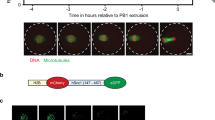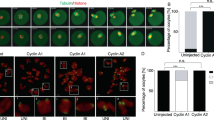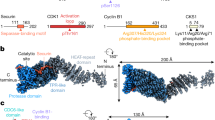Abstract
Disjunction of pairs of homologous chromosomes during the first meiotic division (MI) requires anaphase-promoting complex (APC)-mediated activation of separase in budding yeast1,2 and Caenorhabditis elegans3,4,5, but not Xenopus laevis6,7. It is not clear which model best fits the mammalian system. Here we show that homologue disjunction in mouse oocytes is dependent on proteolysis of the separase inhibitor securin and the Cdk1 regulatory sub-unit cyclin B1. Proteolysis of both proteins was entirely dependent on their conserved destruction box (D-box) motifs, through which they are targeted to the APC8. These data indicate that the mechanisms regulating homologue disjunction in mammalian oocytes are similar to those of budding yeast and C.elegans.
This is a preview of subscription content, access via your institution
Access options
Subscribe to this journal
Receive 12 print issues and online access
$209.00 per year
only $17.42 per issue
Buy this article
- Purchase on Springer Link
- Instant access to full article PDF
Prices may be subject to local taxes which are calculated during checkout

Similar content being viewed by others
References
Buonomo, S.B.C. et al. Cell 103, 387–398 (2000).
Cooper, K.F. et al. Proc. Natl Acad. Sci. 97, 14548–14553 (2000).
Golden, A. et al. J. Cell Biol. 151, 1469–1482 (2000).
Furuta, T. et al. Mol. Biol. Cell 11, 1401–19 (2000).
Siomos, M.F. et al. Curr. Biol. 11, 1825–1835 (2001).
Peter, M. et al. Nature Cell Biol. 3, 83–87 (2001).
Taieb, F.E., Gross, S.D., Lewellyn, A.L. & Maller, J.L. Curr. Biol. 11, 508–513 (2001).
Pfleger, C.M. & Kirschner M.W. Genes & Devel. 15, 2396–2407 (2001).
Hagting, A. et al. J. Cell Biol. 157, 1125–1137 (2002).
Ledan, E., Polanski, Z., Terret, M.E. & Maro, B. Dev. Biol. 232, 400–413 (2001).
Zur, A. & Brandeis, M. EMBO J. 20, 792–801 (2001).
Stemmann et al. Cell 107, 715–726 (2000).
Levasseur, M. & McDougall, A. Devel. 127, 631–641 (2000).
Kanatsu-Shinohara, M., Schultz, R.M. & Kopf, G.S. Biol. Reprod. 63, 1610–1616 (2000).
Hassold, T. & Hunt, P. Nature Rev. Genet. 2, 280–291 (2001).
Clouston, H. et al. Hum. Genet. 101, 30–36 (1997).
Dominguez, A. et al. Oncogene 17, 2187–2193 (1998).
Acknowledgements
We thank M. Sinclair and K Wilson for technical assistance, J. Pintor-Toro for human securin cDNA, J. Pines for human cyclin B1 cDNA, and J. Lukas for securin monoclonal antibody. This work was supported by a grant from Newcastle University Hospitals Special Trustees. H.H. is supported by a WellBeing Research Training Fellowship. The Wellcome Trust supported work in the McDougall lab.
Author information
Authors and Affiliations
Corresponding authors
Ethics declarations
Competing interests
The authors declare no competing financial interests.
Supplementary information
Supplementary Information, Fig. S1
Supplementary Information, Fig. S2 (DOC 177 kb)
Rights and permissions
About this article
Cite this article
Herbert, M., Levasseur, M., Homer, H. et al. Homologue disjunction in mouse oocytes requires proteolysis of securin and cyclin B1. Nat Cell Biol 5, 1023–1025 (2003). https://doi.org/10.1038/ncb1062
Received:
Accepted:
Issue Date:
DOI: https://doi.org/10.1038/ncb1062
This article is cited by
-
Meiosis resumption in human primordial germ cells from induced pluripotent stem cells by in vitro activation and reconstruction of ovarian nests
Stem Cell Research & Therapy (2022)
-
CENP-F-dependent DRP1 function regulates APC/C activity during oocyte meiosis I
Nature Communications (2022)
-
A prometaphase mechanism of securin destruction is essential for meiotic progression in mouse oocytes
Nature Communications (2021)
-
Prc1-rich kinetochores are required for error-free acentrosomal spindle bipolarization during meiosis I in mouse oocytes
Nature Communications (2020)
-
Cdk1 inactivation induces post-anaphase-onset spindle migration and membrane protrusion required for extreme asymmetry in mouse oocytes
Nature Communications (2018)



